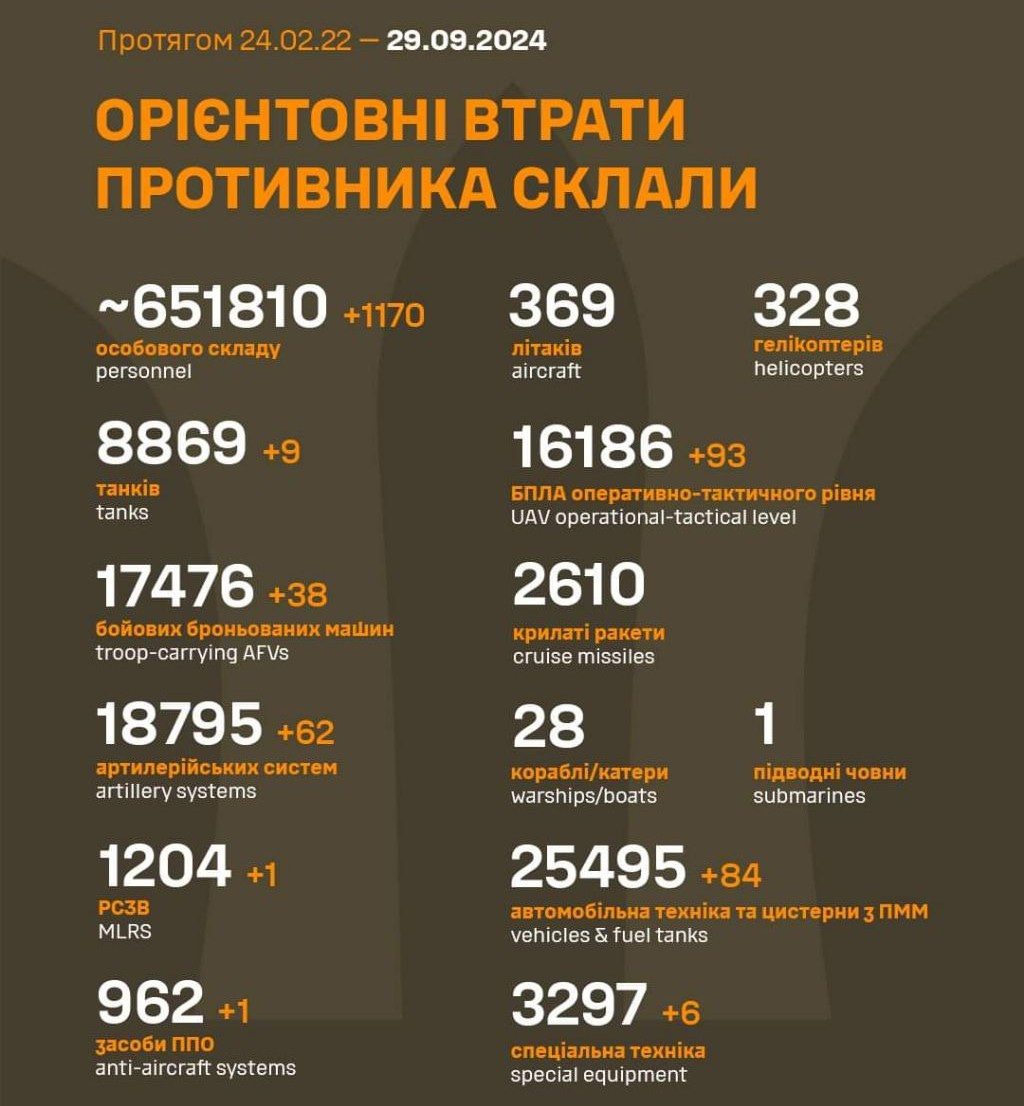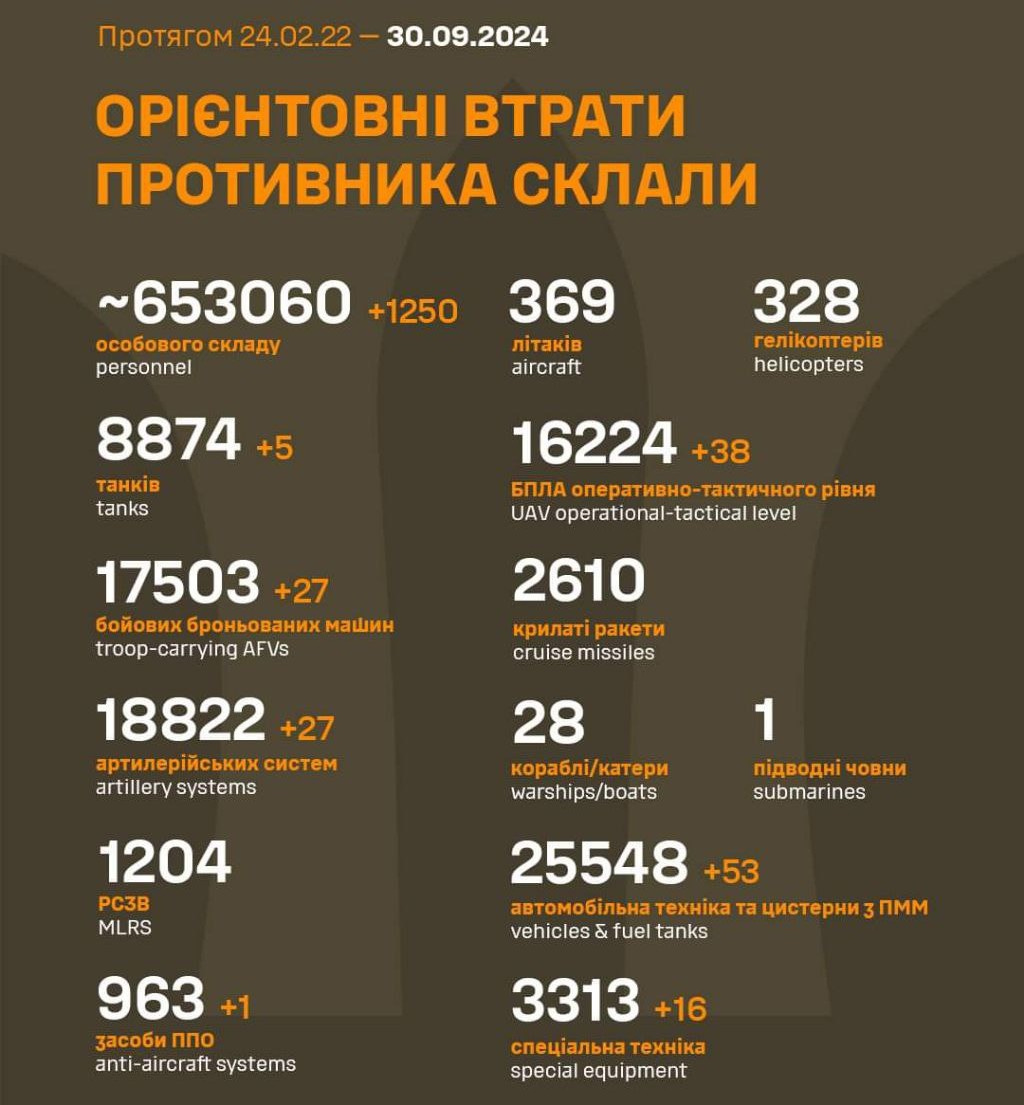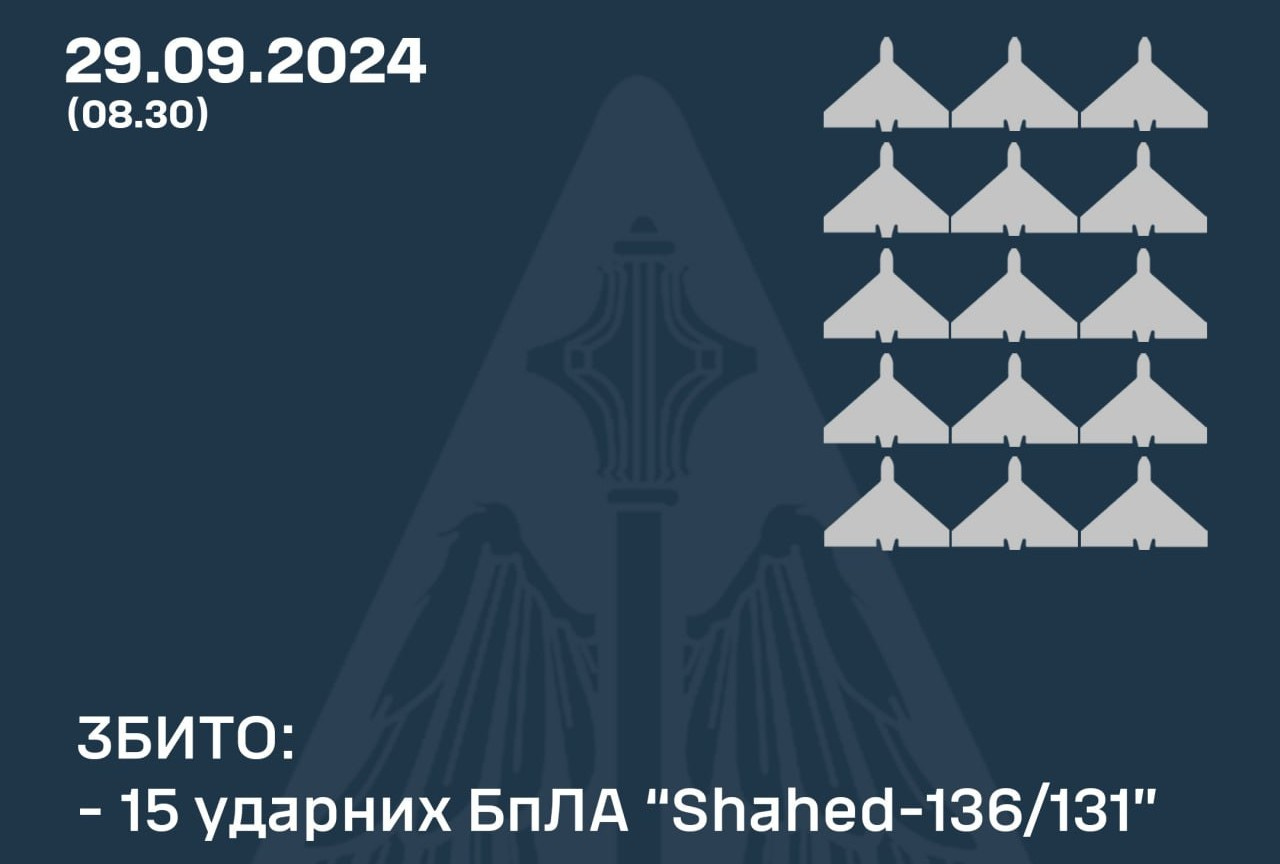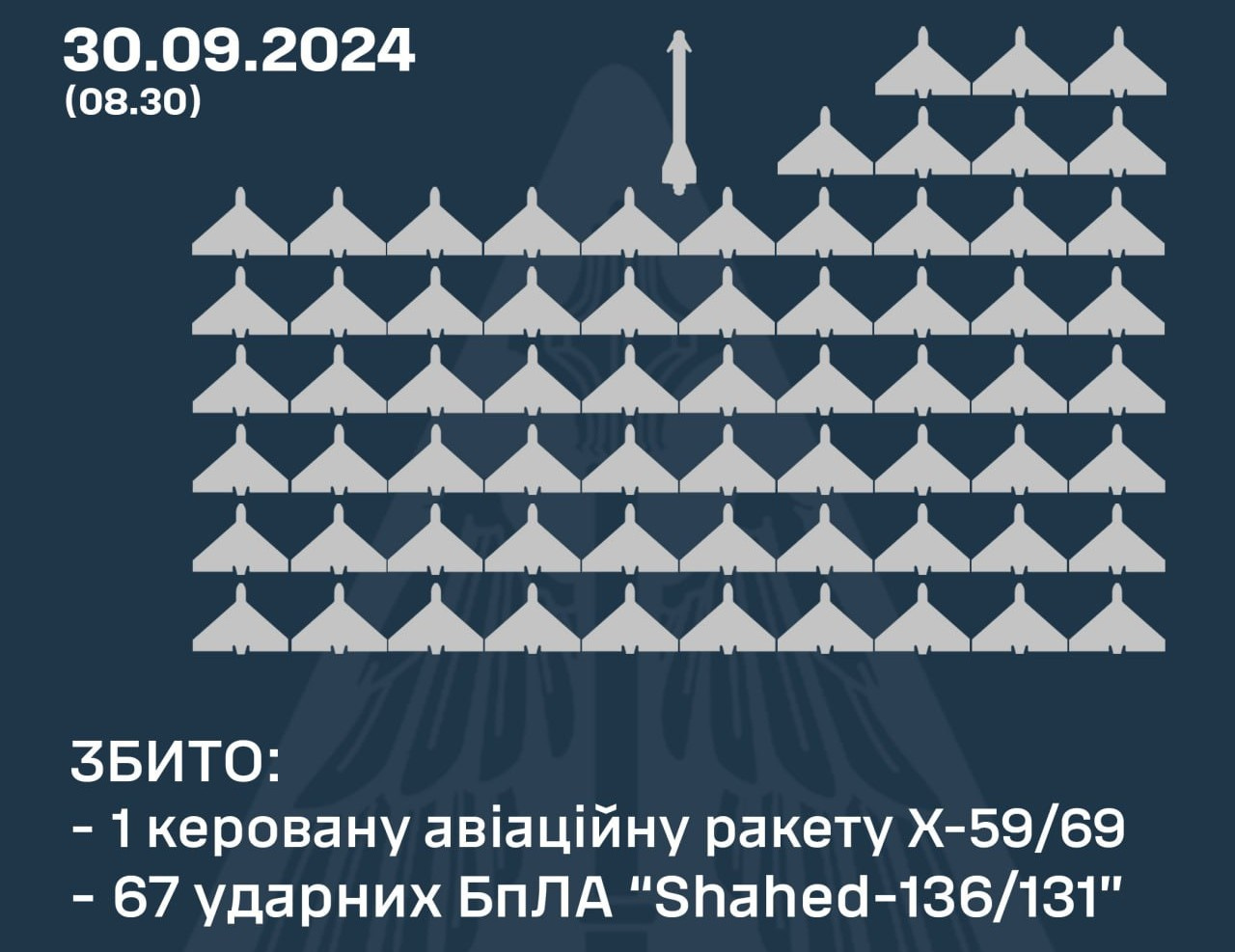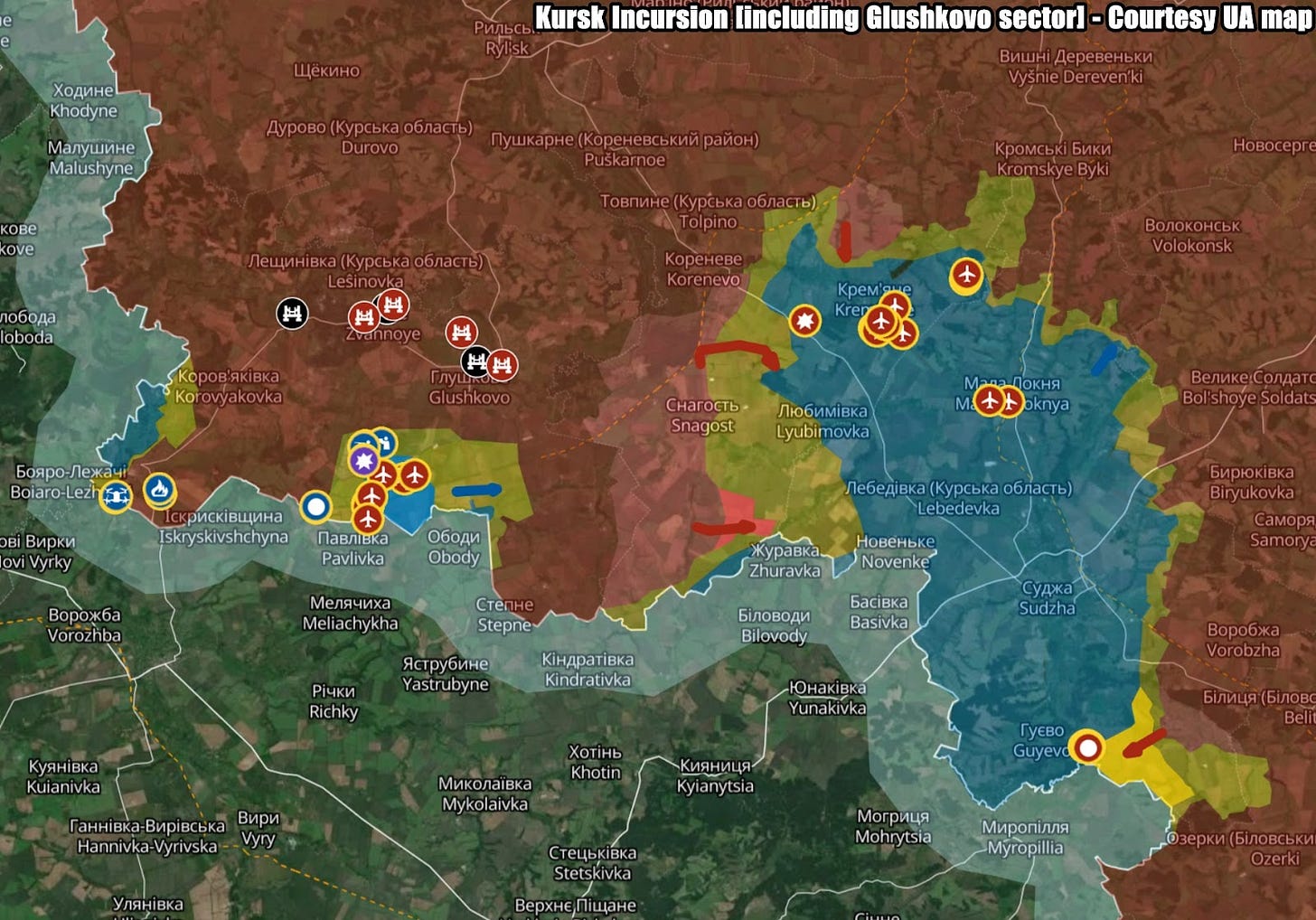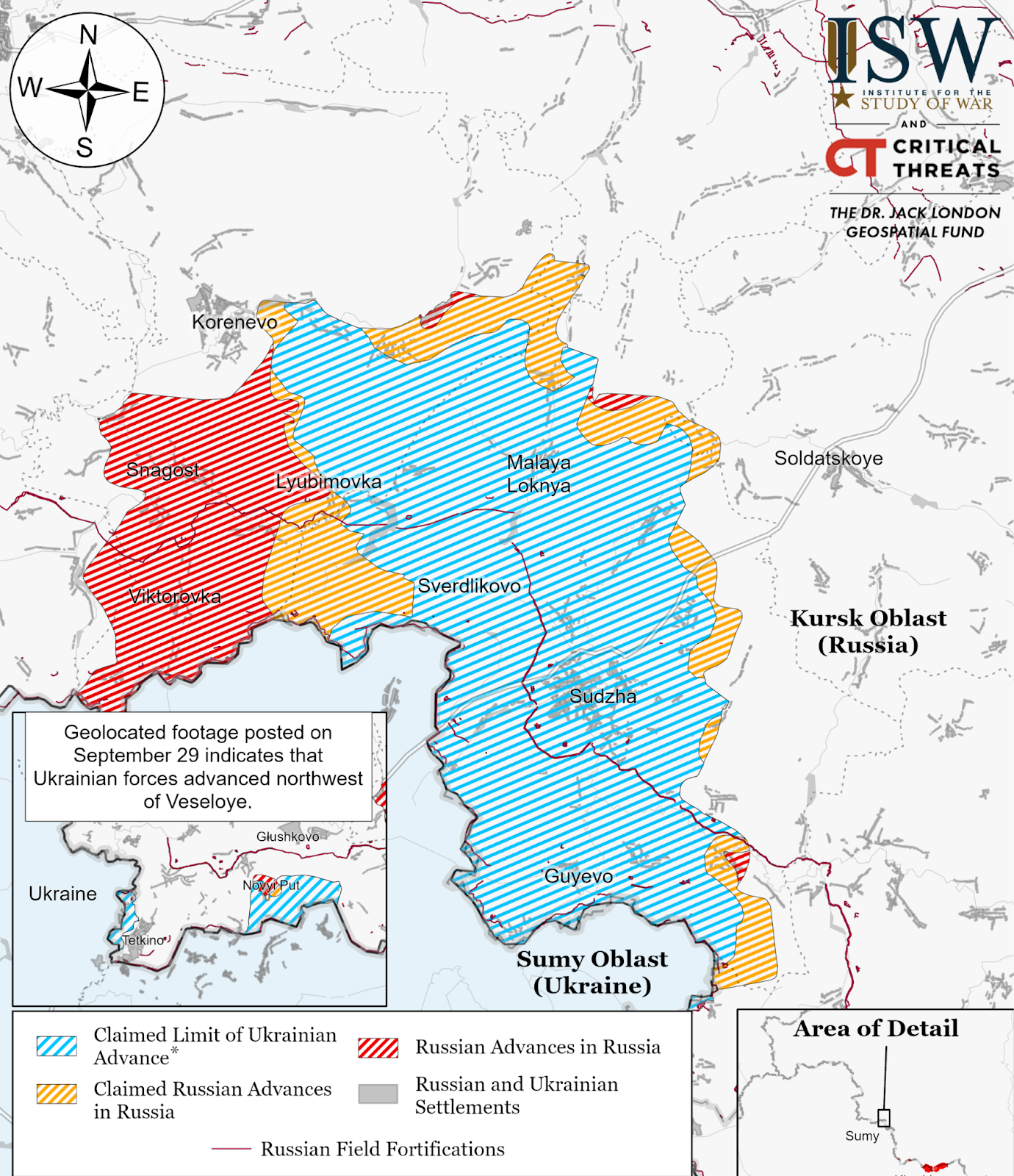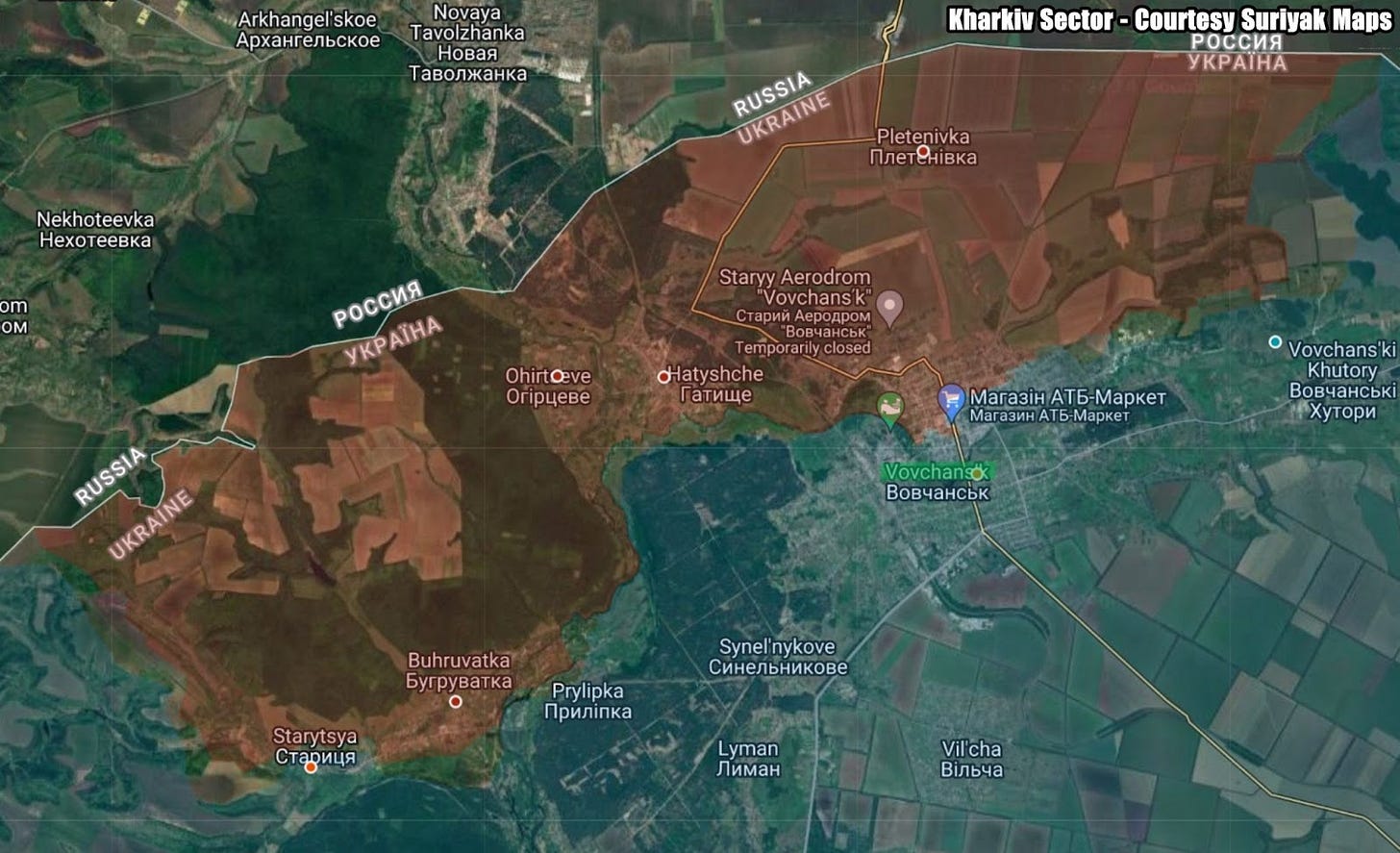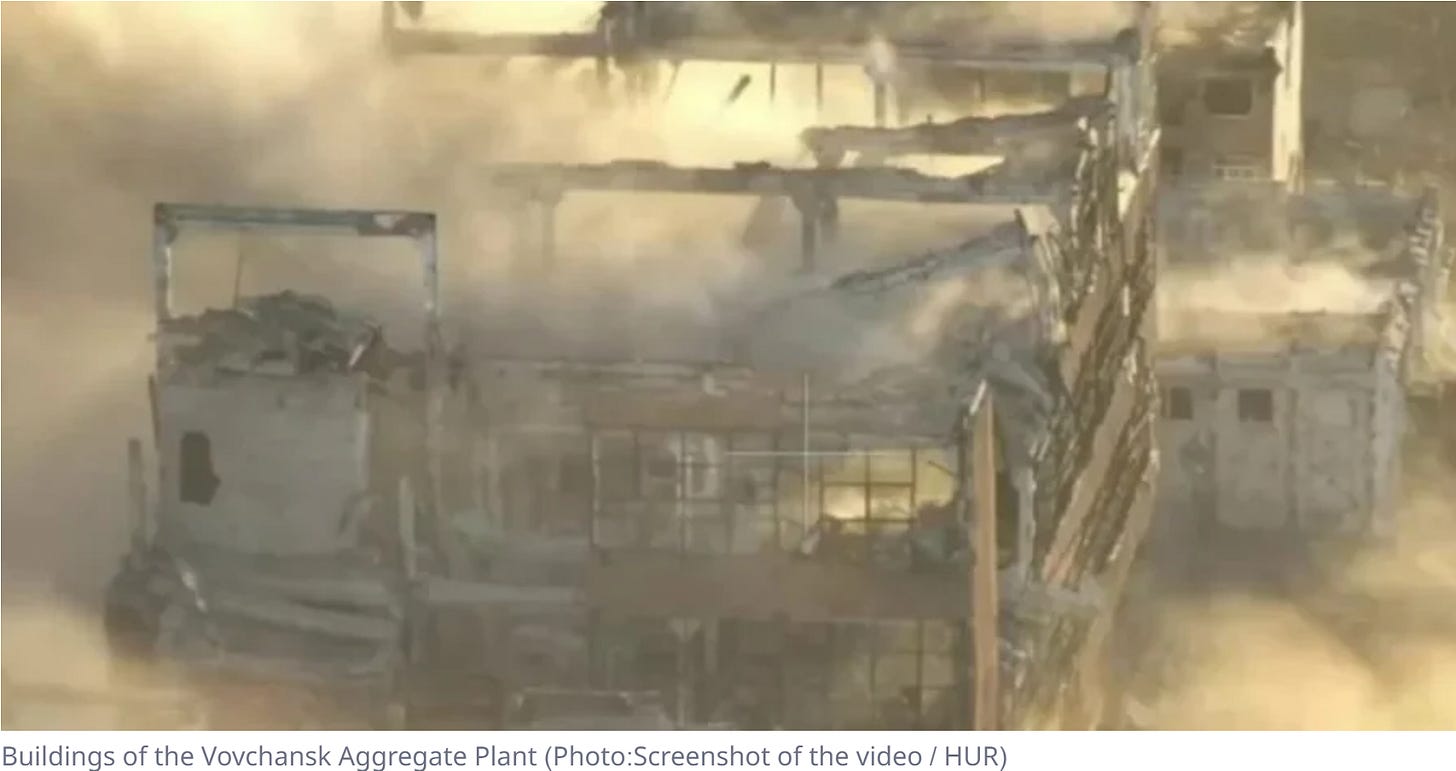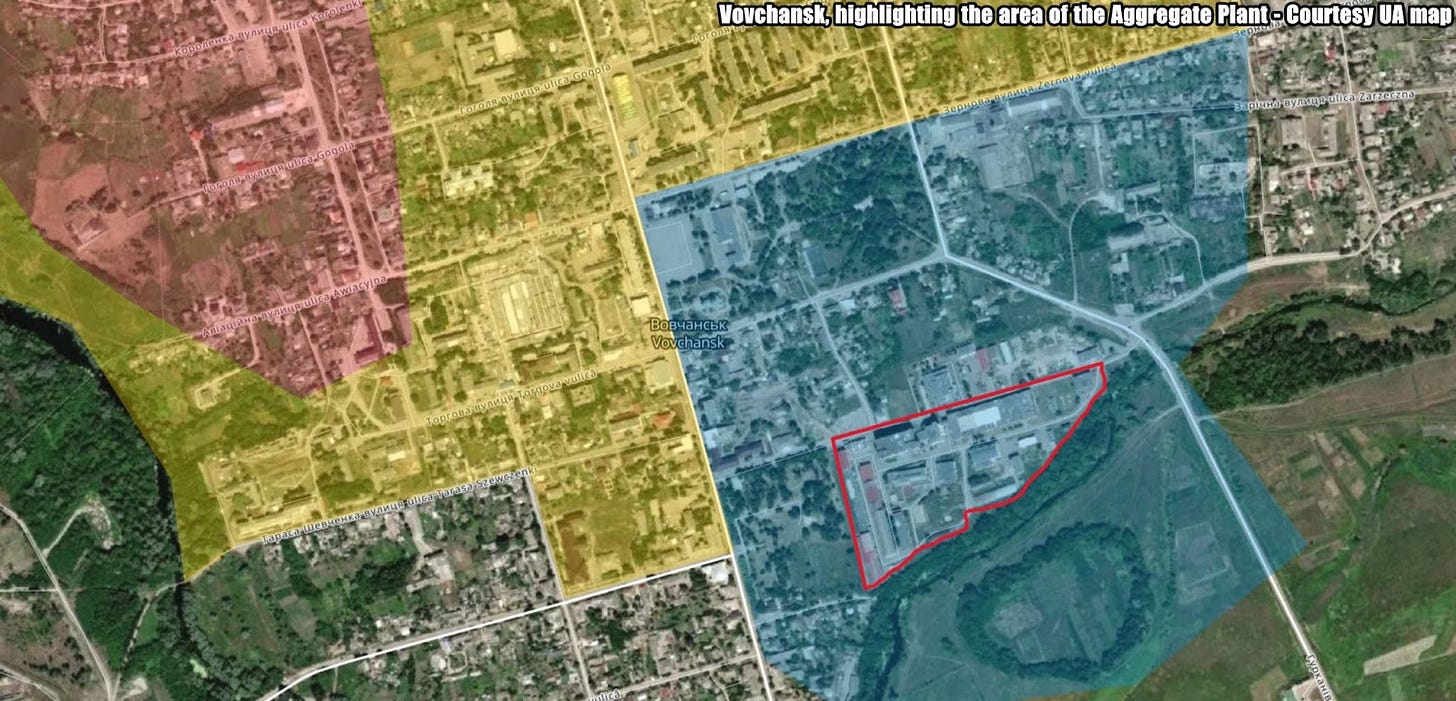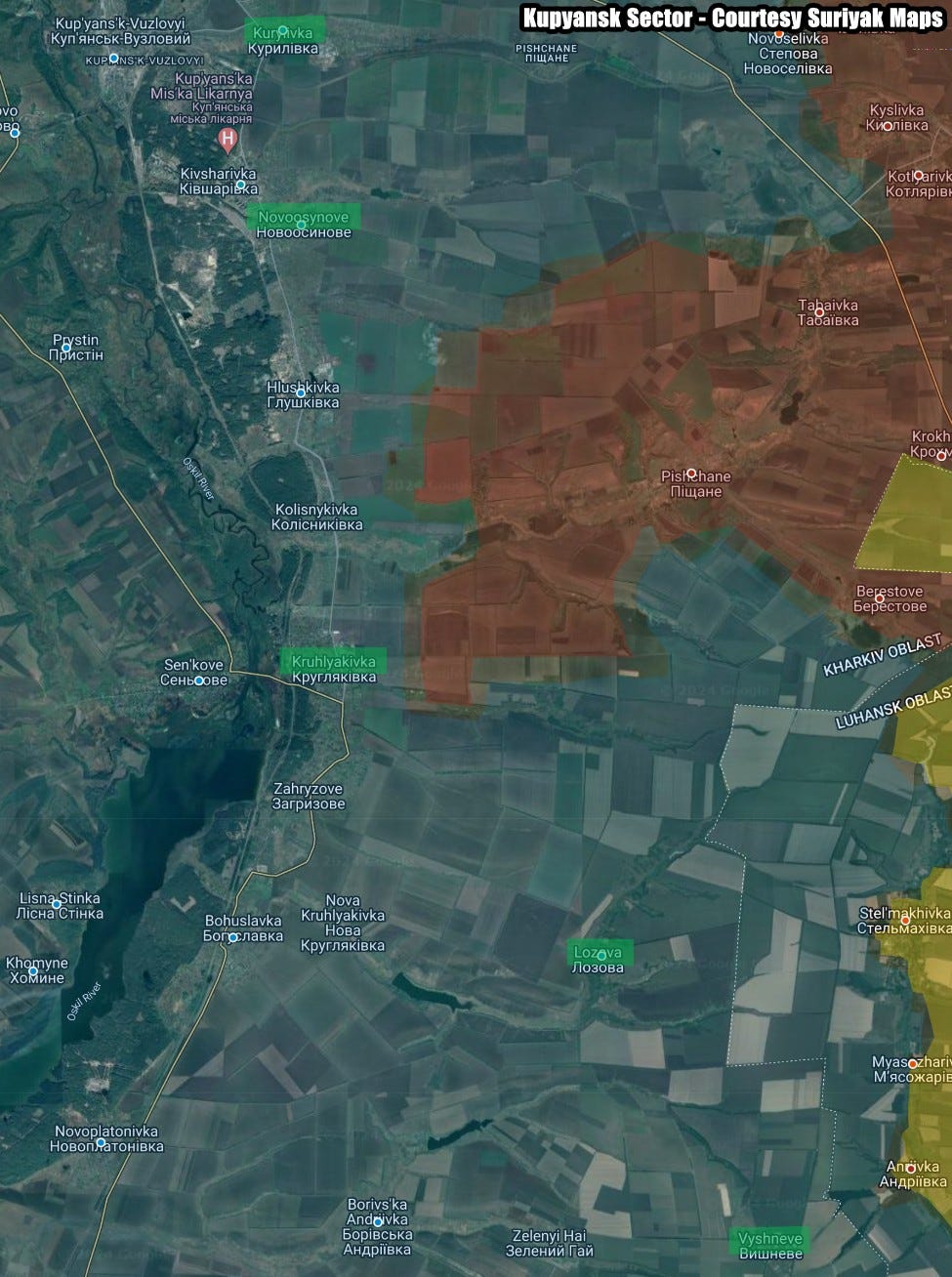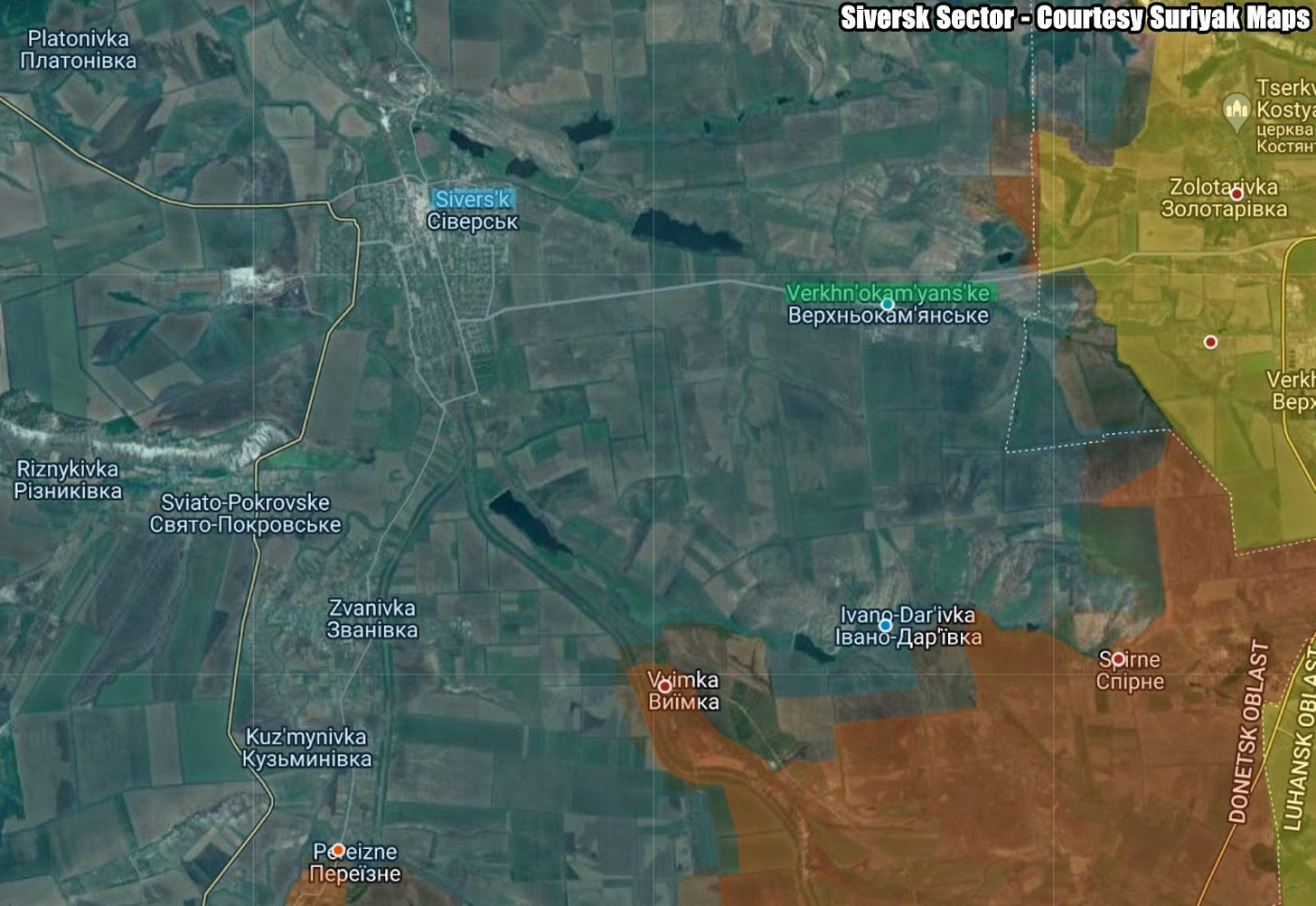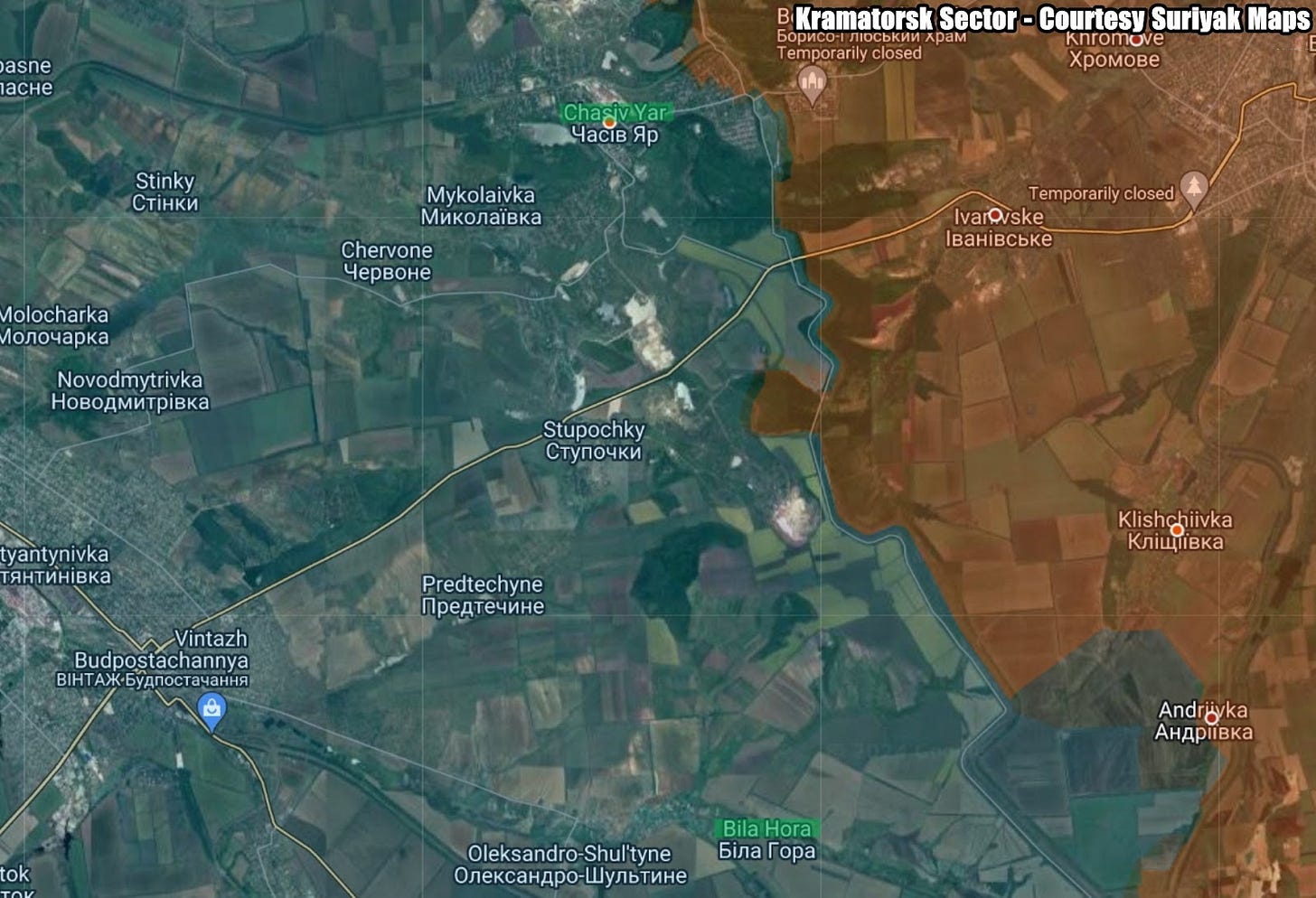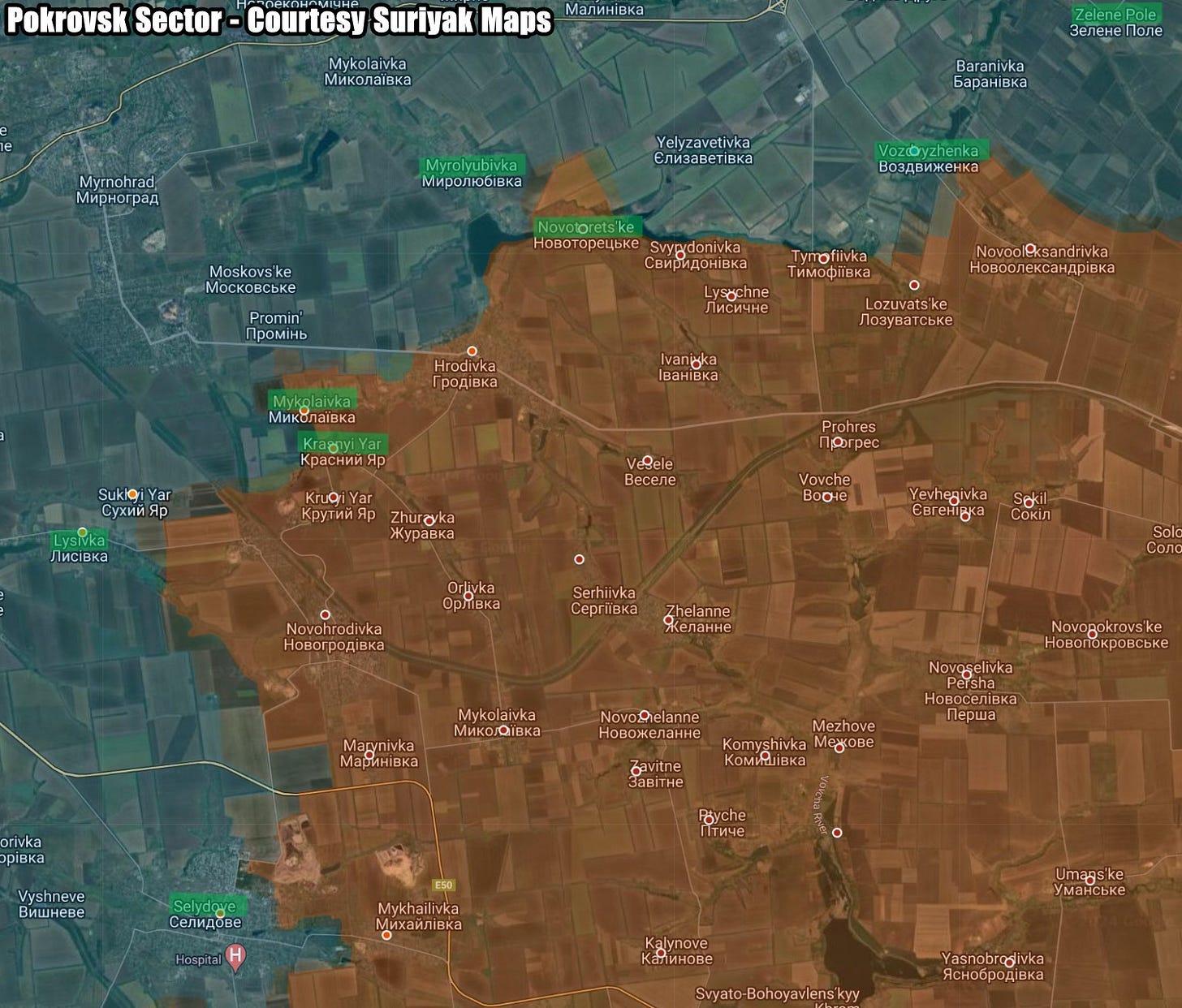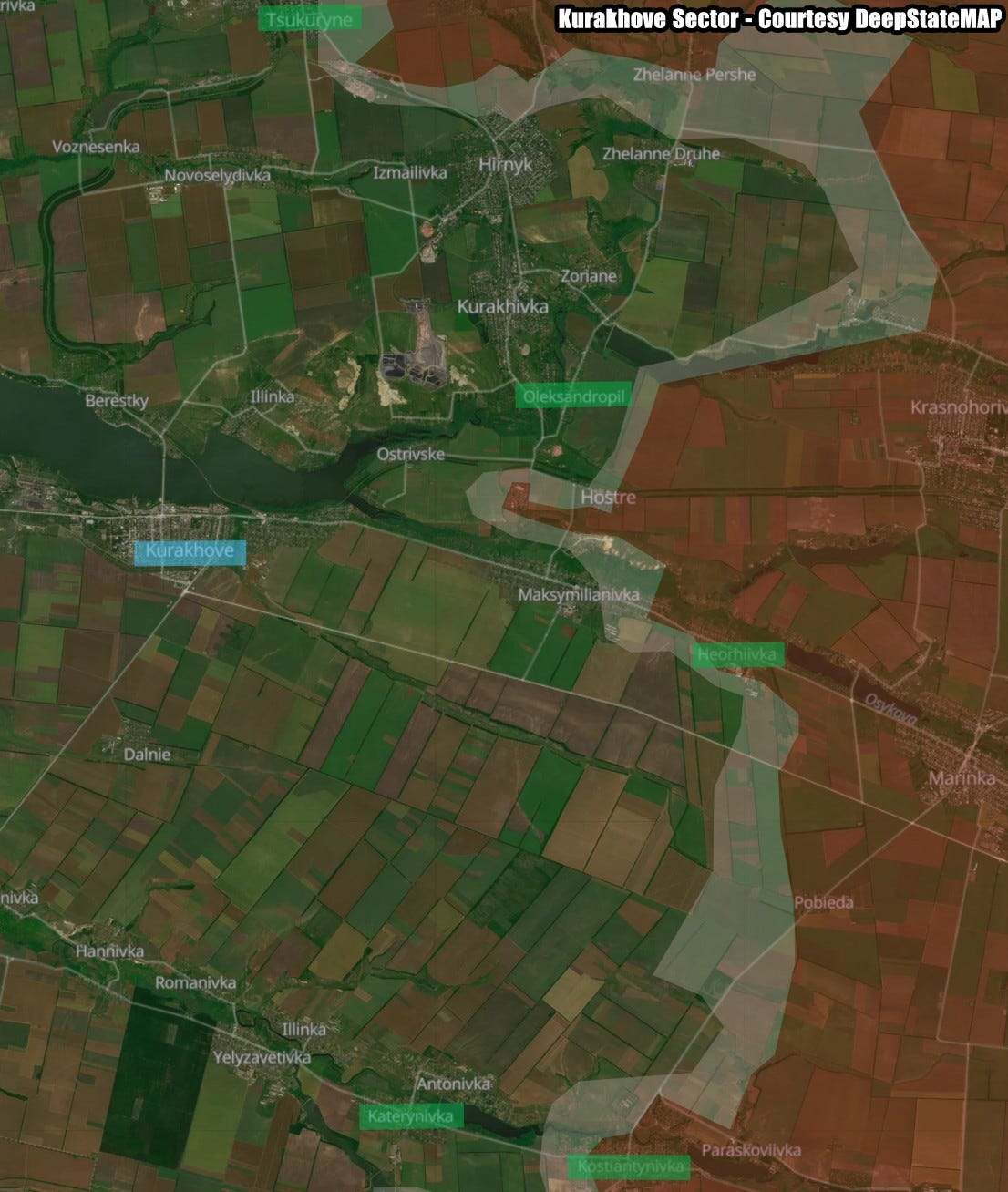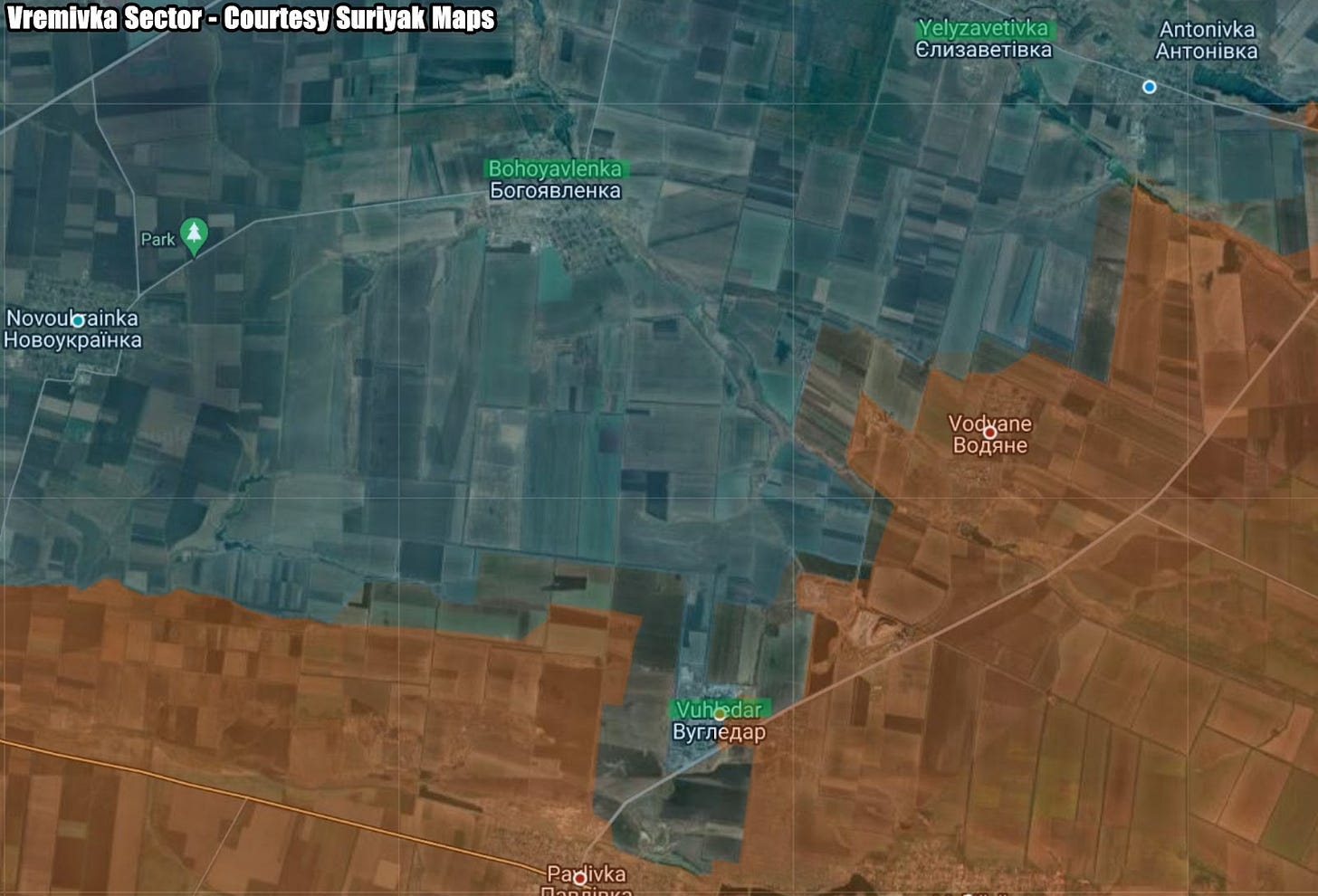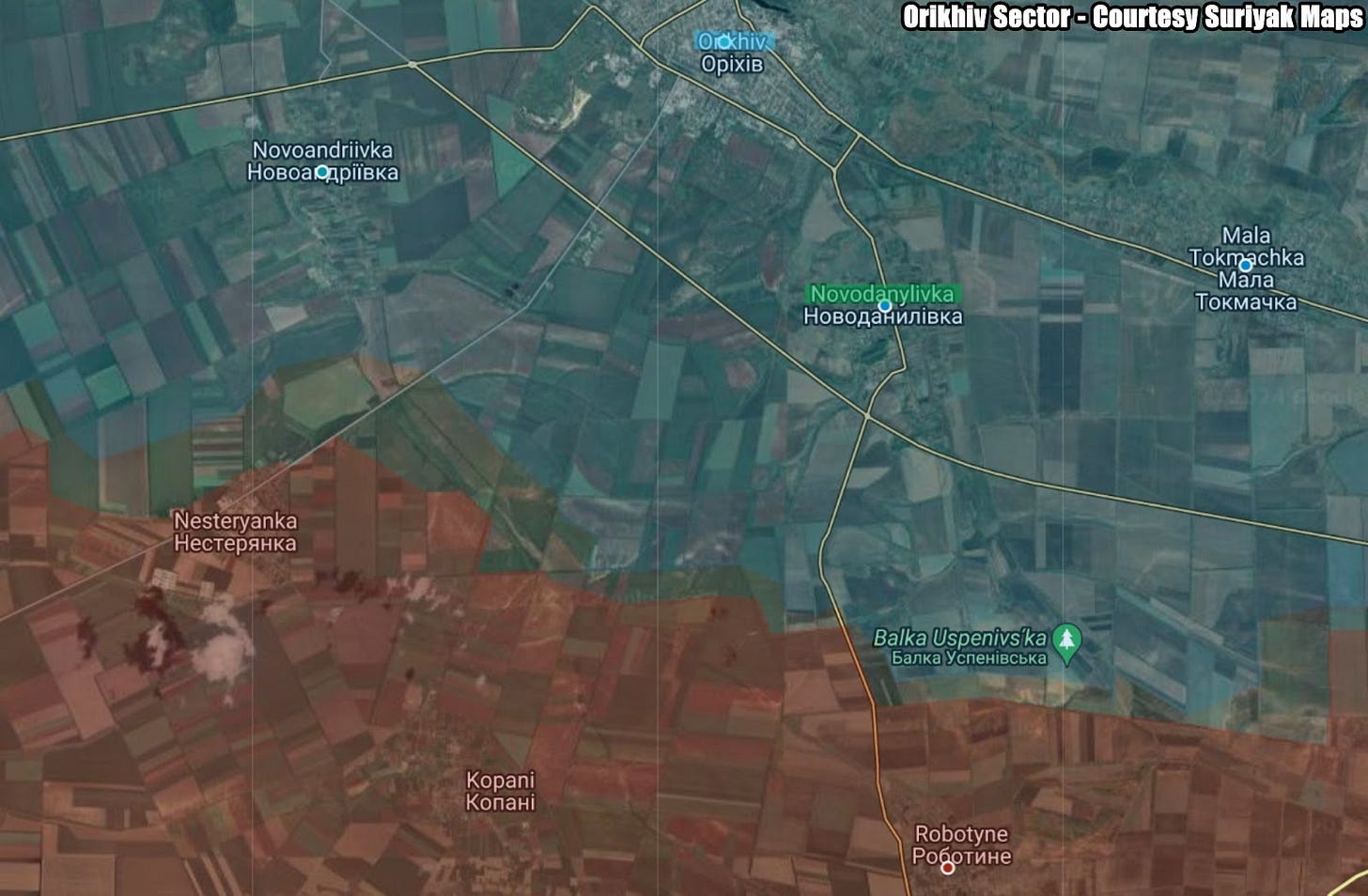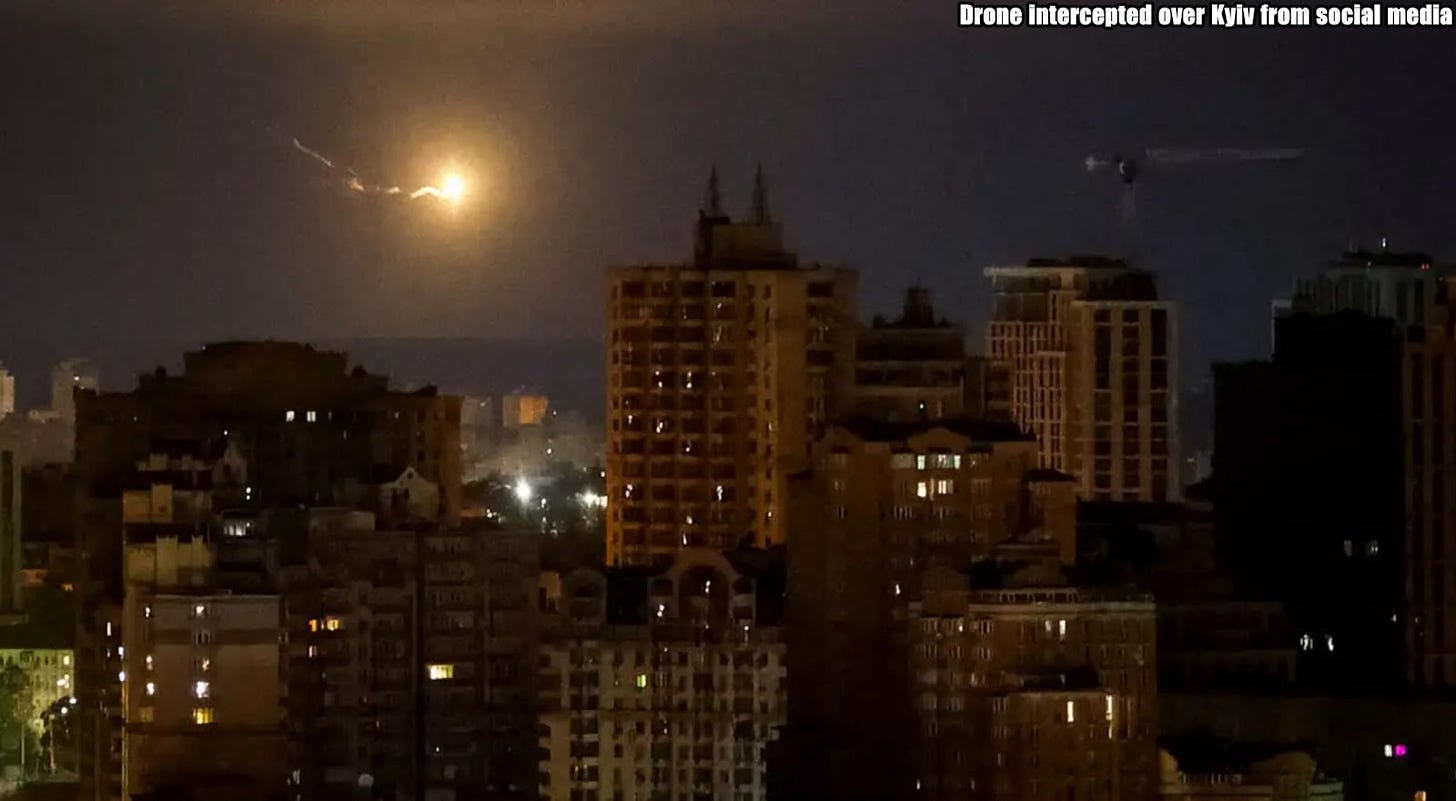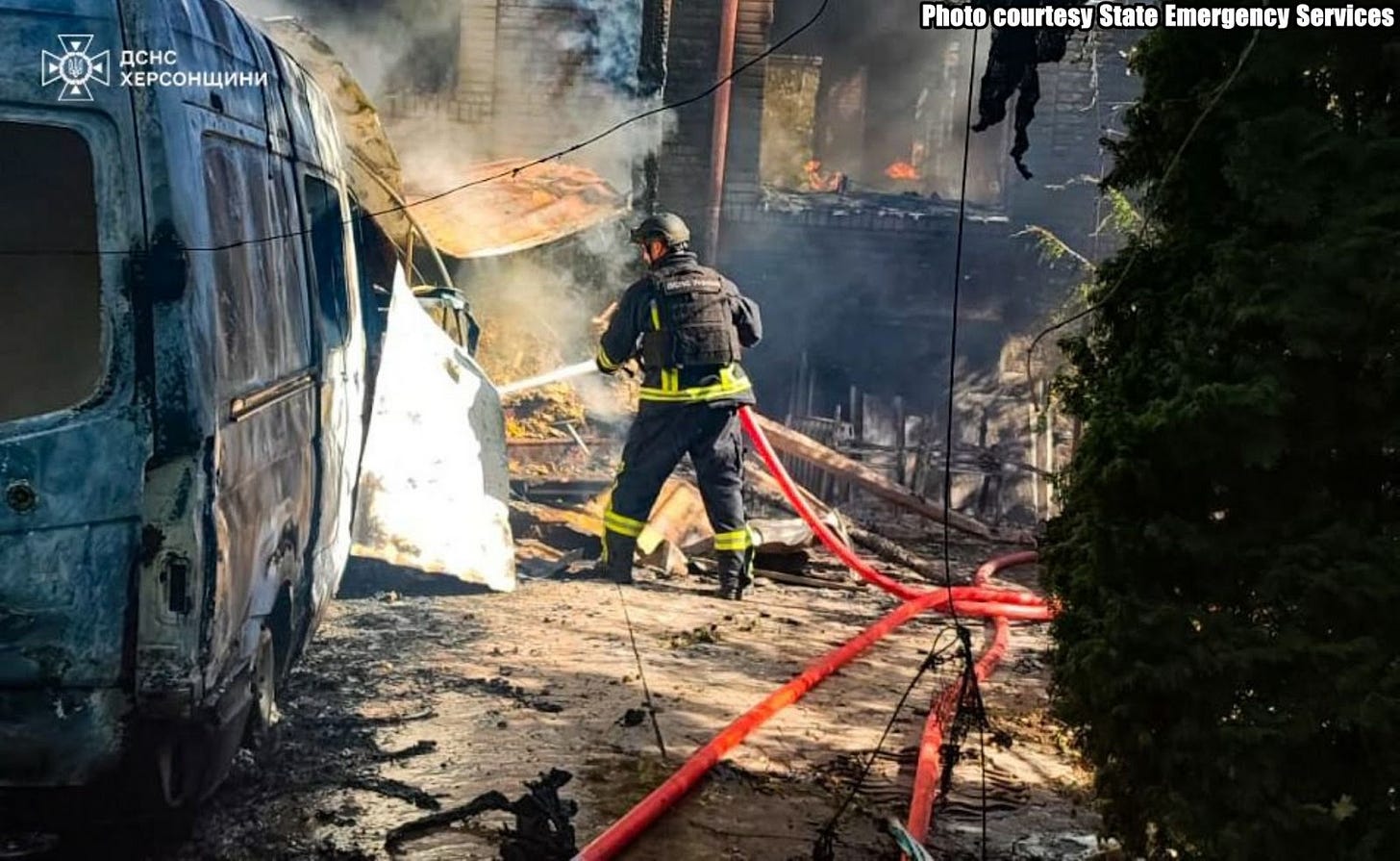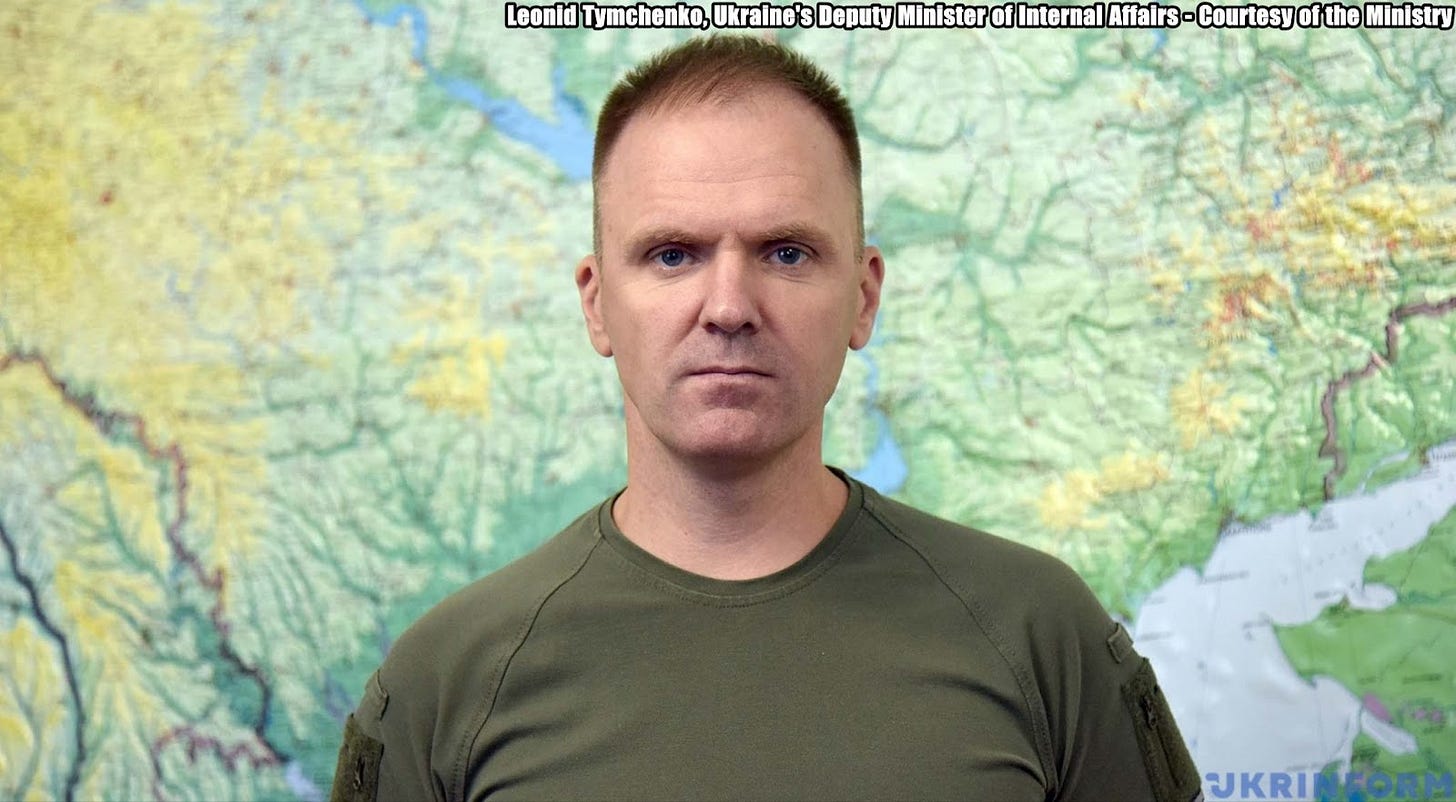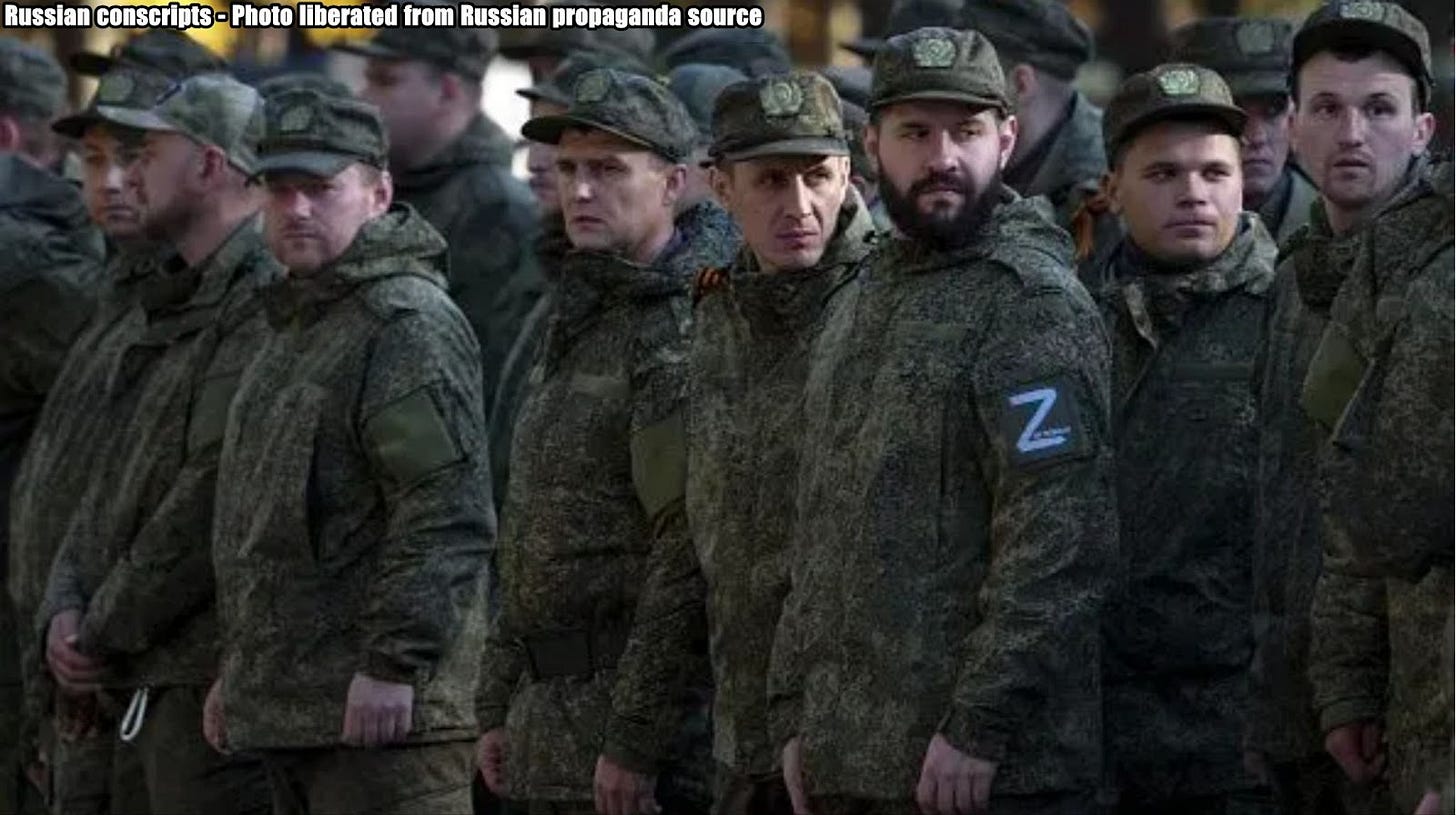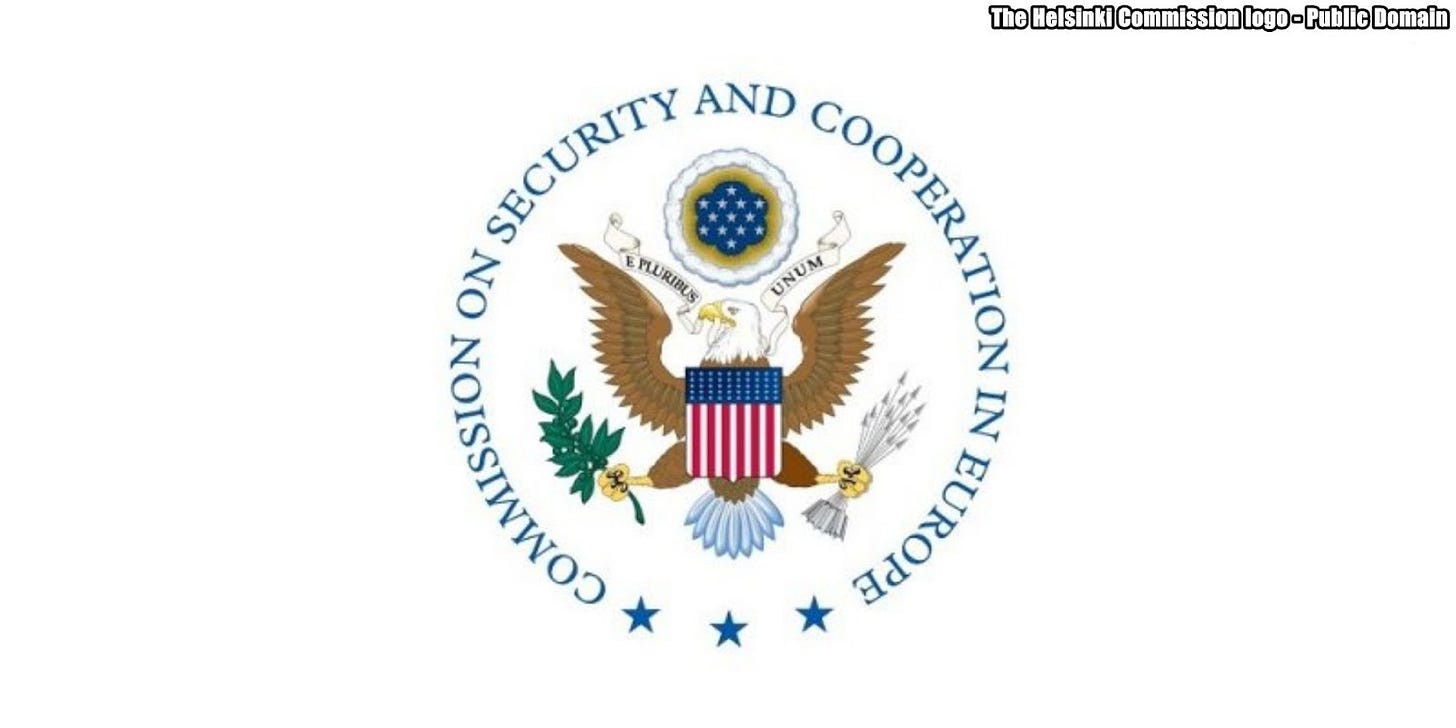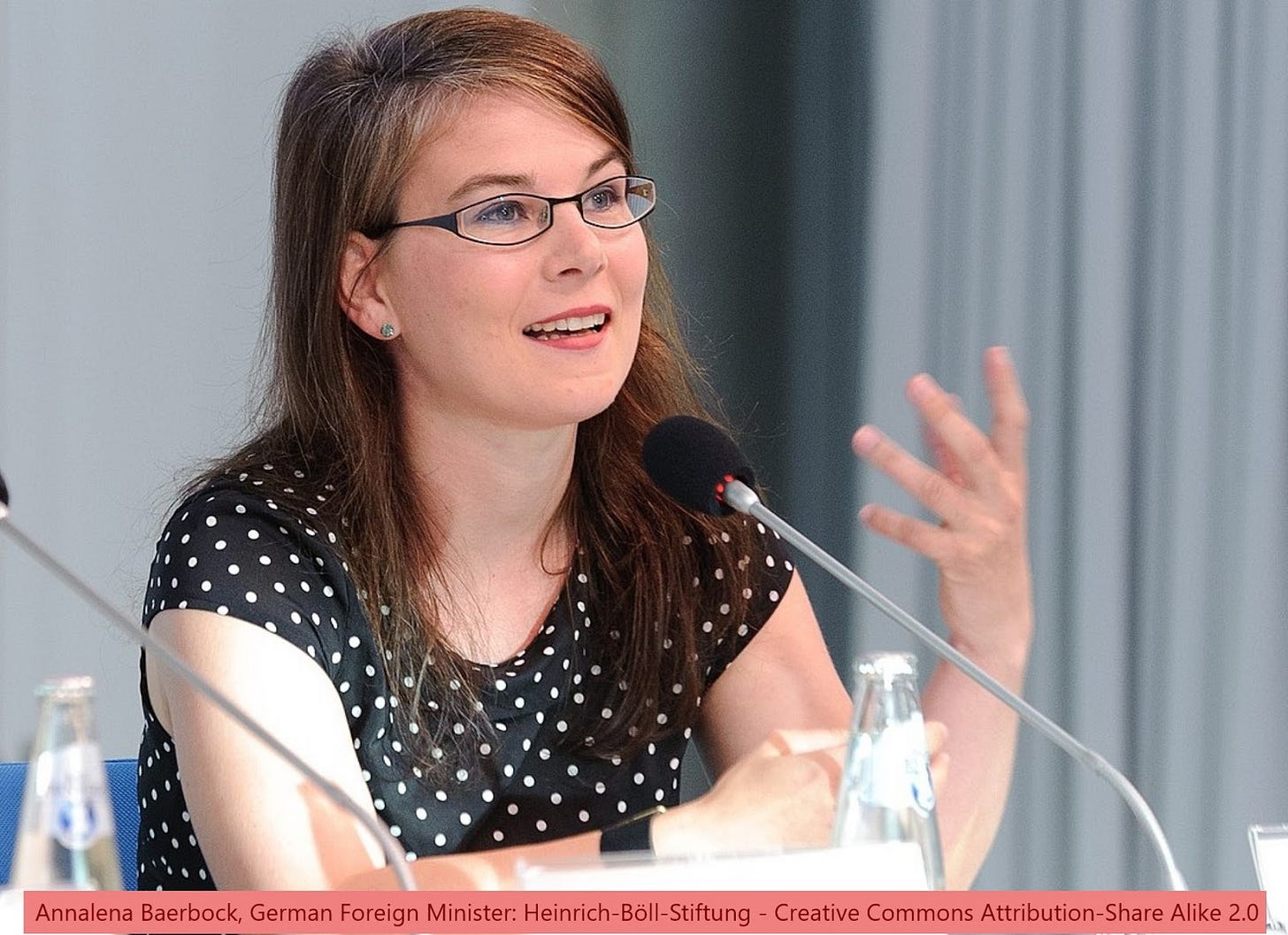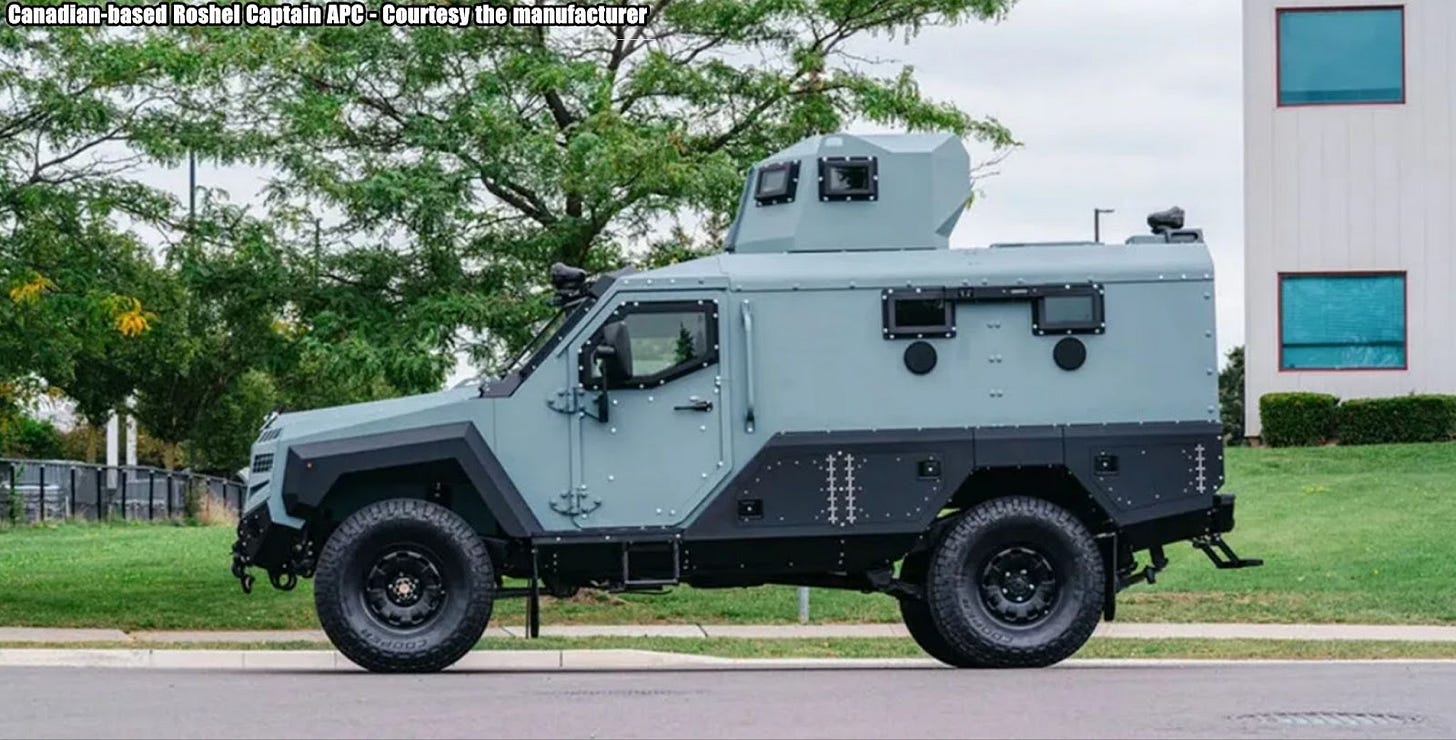Slava Ukraini! In early 2022 I began a Telegram channel aggregating news from a number of sources daily on the war in Ukraine. In June 2023 I began providing a daily draft for the Ukraine War Brief Podcast collecting news from over 70 sources daily, much of which formed the basis of the script. While the Podcast no longer exists I have continued to make this Brief available both on my own Substack and The People’s Media for those who wish to keep up with events on a daily basis.
All the latest news on the Russo-Ukraine War 6 days per week
ALONG THE CONTACT LINE
GSAFU Morning Report
The General Staff of the Armed Forces of Ukraine in its Operational Information update at 22:00 on Sep 29 stated that day 950 of the full-scale invasion of the Russian Federation against Ukraine was about to begin.
During the last two days, 272 combat engagements took place. Over the past 48 hours, the enemy carried out 2 missile strikes, 120 air strikes, 1,328 drone strikes and more than 6,700 artillery strikes across the positions of Ukrainian forces.
At the same time, Ukrainian soldiers continue to inflict losses in manpower and equipment on the occupying troops, exhausting the enemy along the entire front line and continue to disrupt the plans of Russian occupiers to advance deep into the territory of Ukraine.
-
Air Force Daily Report
On the night of Sep 29, 2024, the enemy launched 22 attack UAVs of the "Shahed" type over Ukraine (launch areas: Yeisk, Kursk - Russian Federation, Chauda - Crimea).
As a result of anti-aircraft combat, 15 attack UAVs were shot down in the Sumy, Vinnytsia, Mykolaiv, and Odesa regions by the aviation, MVG, and ERB of the Defense Forces of Ukraine. As a result of countermeasures by EW, five more enemy drones were lost in location, previously without consequences.
On the night of Sep 30, 2024 (from 19.00 on 29.09 to 08.00 on 30.09), the enemy attacked Ukraine with missiles of various types and attack UAVs. A total of 76 means of air attack of the enemy were detected and escorted by the radio engineering troops of the Air Force:
- one "Iskander-M" ballistic missile from the occupied Crimea;
- one Kh-59/69 guided air missile from the airspace of the TOT of the Zaporizhia region;
- one Kh-31P anti-radar missile from the airspace over the Black Sea;
- 73 strike UAVs of the "Shahed" type from the Kursk, Yeisk, Orel regions - Russian Federation.
The air attack was repulsed by aviation, anti-aircraft missile forces, electronic warfare units and mobile fire groups of the Air Force and the Defense Forces of Ukraine.
As a result of anti-aircraft combat, one Kh-59/69 guided air missile and 67 enemy attack UAVs of the "Shahed" type were shot down in the Kyiv, Cherkasy, Vinnytsia, Kirovohrad, Zhytomyr, Poltava, Chernihiv, Sumy, Kharkiv, Dnipropetrovsk, and Mykolaiv regions.
One drone flew in the direction of Belarus, three more were lost in location in the northern regions of Ukraine as a result of countermeasures by EW. One UAV remains in the airspace of Ukraine, combat work is underway.
The Russian Border Incursion
Ukrainian forces recently advanced in Glushkovsky Raion west of the Ukrainian salient in Kursk Oblast amid continued Ukrainian offensive operations in the area on Sep 29. Geolocated footage published on Sep 29 indicates that Ukrainian forces recently advanced west and northwest of Veseloye (south of Glushkovo) and likely seized the northwestern part of the settlement. Russian milbloggers credited elements of the Russian 56th Airborne (VDV) Regiment (7th VDV Division) with repelling Ukrainian attacks near Veseloye.
Ukrainian forces continued assaults in the Ukrainian salient in Kursk Oblast on Sep 29, but did not make any confirmed advances. Russian sources claimed that Ukrainian forces attacked southeast of Korenevo near Lyubimovka; east of Korenevo near Kremyanoye; and north of Sudzha near Pogrebki, Kamyshevka, and Cherkasskoye Porechnoye. Russian milbloggers noted that Ukrainian forces are likely operating within Olgovka (east of Korenevo).
Russian forces counterattacked near the Ukrainian salient in Kursk Oblast on Sep 29, but did not make any confirmed advances in the area. Russian sources claimed that Russian forces counterattacked southeast of Korenevo near Lyubimovka, Darino and Nikolayevo-Darino and south of Sudzha near Plekhovo. Ukrainian military observer Kostyantyn Mashovets noted that elements of the Russian 7th and 106th VDV divisions, 810th Naval Infantry Brigade (Black Sea Fleet [BSF], Southern Military District [SMD]), and 155th Naval Infantry Brigade (Pacific Fleet, Eastern Military District [EMD]) are attempting to consolidate their current positions and are preparing to defend against future Ukrainian attacks in Kursk Oblast. Mashovets estimated that Russian forces have concentrated between 40,000 and 41,000 personnel in Kursk Oblast and intend to redeploy an additional 6,000 personnel to the area.
The Khortytsia operational-strategic group
(Responsible for the northeastern part of Ukraine. )
Kharkiv Sector: Over the last day Ukrainian Defense Forces repelled 3 Russian attacks near Vovchansk. 1 engagement continues.
Russians fire all available weapons at Vovchansk plant liberated by Ukraine
Russian troops are using the entire variety of weapons at their disposal to strike at the Vovchansk Aggregate Plant, which was recently liberated by units of Ukraine’s Defence Intelligence [HUR]. Ukrainska Pravda reported citing Colonel Vitalii Sarantsev, spokesperson for the Kharkiv Operational and Tactical Group during a recent interview.
Sarantsev said that the situation on the Kharkiv front remains difficult, as the Russians continue to assault the positions of the Ukrainian defence forces. The town of Vovchansk remains the hottest spot.
In particular, the situation on the territory of the Vovchansk Aggregate Plant after its liberation and the mop-up operation by Ukraine’s Defence Intelligence is the most difficult and tense, as the plant has become the Russians’ number one target. Sarantsev noted that the plant was not a tactical target for the Russians, but its loss was a powerful blow to their image as a prevailing force.
"The enemy is currently trying to use the maximum variety of their weapons in that location. They are using a TOS-1A heavy flamethrower system and launching aerial bombs. In other words, they are following their standard practice of destroying what they have not managed to capture."
Kupyansk Sector: Russian Forces carried out 12 unsuccessful offensive actions against Ukrainian defensive positions near Kuryiivka, Novoosynove, Kruhlyakivka, Lozova and Vyshneve, 1 engagement continues.
Lyman Sector: Russian Forces carried out 12 offensive actions against Ukrainian defensive positions near Makiivka, Nevske, Zarichne, Serebryansky Forest and Bilhorivka.
Siversk Sector: Russian forces carried out 1 unsuccessful assault in the vicinity of Verkhnokamianske.
Kramatorsk Sector: Russian forces carried out 6 offensive actions near Chasiv Yar and Bila Hora. 1 engagement continues.
Toretsk Sector: Russian forces carried out 11 offensive actions with air support near Toretsk, Shcherbynivka and Nelipivka. 4 engagements continue.
The Tavria operational-strategic group
(Responsible for the central-eastern and southeastern part of Ukraine.)
Pokrovsk Sector : Russian forces conducted 28 attacks against Ukrainian defences in this area over the last day in the vicinity of Zelene Pole, Vozdvyzhenko, Novotoretske, Myrolyubivka, Mykolaivka, Krasnyi Yar, Lysivka and Selydove.
Kurakhove Sector: The enemy, supported by aviation, made 23 assaults on Ukrainian positions near Tsukuryne, Oleksandropil, Heorhiivka, Katerynivka and Konstantinivka.
Vremivka Sector: Russian forces made 17 assaults against Ukrainian positions near Bohoyavlenka, Vuhledar and Yelyzavetivka, 2 engagements continue.
Orikhiv Sector: Russian forces made 3 assaults against Ukrainian positions near Novodanylivka.
The Odesa operational-strategic group
(Responsible for Kherson, Qırım, (also known as Crimea) and the Black Sea.)
Prydniprovsk Sector: There has been no significant change in the combat environment in the last 24 hours.
TEMPORARILY OCCUPIED TERRITORIES
Nothing major to report.
THE HOME FRONT
Massive Russian drone swarm targets Kyiv.
Russia launched several waves of drones targeting Kyiv early on Monday. DW reports.
According to preliminary information, no casualties or damage have been reported. The air force said it had shot down 67 of the 73 drones and one of the three missiles fired by Russia during the attack.
Ruslan Kravchenko, Head of Kyiv Oblast Military Administration said: "The enemy assets have been destroyed. There were no casualties. There were no hits to critical or residential infrastructure.
The wreckage from the downed targets was found in 6 districts of the oblast. Grass and stubble caught fire in five districts of the oblast due to the fall of the wreckage from the downed targets."
The police reported that a residential building had caught fire in one of the districts of the oblast. Firefighters contained the fire. Wreckage also damaged a cemetery in another district.
Ukraine reports 55,000 missing amidst prolonged war with Russia
Ukraine has officially recognized 55,000 individuals as missing due to Russia's aggressive war, the majority of whom are military personnel, said Deputy Minister of Internal Affairs Leonid Tymchenko, reports Ukrinform. "This number is quite dynamic: when the whereabouts of missing persons are established, in some cases it turns out that the individual is, for instance, in captivity," Tymchenko explained, adding that periodically they confirm deaths among those previously considered missing.
A unified registry for missing persons was launched in Ukraine in May 2023. At the time, the Ministry of Internal Affairs reported 23,000 missing individuals. By July 2024, the ministry updated the registry to include 42,000 Ukrainians.
RUSSIAN WORLD
Russia aims to draft 133,000 during new round of fall conscription
Russia is planning to draft 133,000 Russians between October and January, according to a decree signed by President Vladimir Putin on Sep 30. The Kyiv Independent reports.
Men aged from 18 to 30 will be drafted as part of the regularly occurring fall conscription campaign. The decree applies to Russians who are not in the reserve and are subject to military service. Those soldiers whose service has already expired are to be dismissed.
The fall 2023 conscription included the illegally annexed areas of Luhansk, Donetsk, Kherson, and Zaporizhzhia oblasts. The U.K. Defense Ministry said in March that it is likely recruiting around 30,000 people a month to help bolster its war effort.
Ukraine adopted a law on mobilisation in April as part of an effort to replenish the ranks of the Armed Forces. The need to increase the number of troops persists as Russia continues to advance in Donetsk Oblast and Ukraine after opened a new front in Russia's Kursk Oblast.
Recent legislation reforms pertaining to mobilisation also included a law lowering the minimum age of compulsory military service from 27 to 25.
After the law came into force in Ukraine on May 18, military-aged men were given 60 days to update their personal data so that the state could locate them.
Between May 18 and the mid-July deadline, over 4,6 million military-aged men had done so, the country's Defense Ministry said.
Ukrainian drones strike Volgograd ammunition depot 300 km from border
A fleet of 120 Ukrainian drones struck a Russian ammunition warehouse in Volgograd Oblast, Euromaidan Press reports.
The Ukrainian military confirmed they struck a major Russian storage arsenal of missile and artillery weapons, located near the village of Kotluban in Volgograd Oblast, on the night of 29 September.
The distance from Kotluban to the Ukrainian border is roughly 300-350 kilometres (about 186-217 miles). According to the report, an echelon of Iranian missiles arrived at this arsenal on the eve of the strike.
Earlier in September, Iran provided Russia with close-range Fath-360 ballistic missiles for potential use in Ukraine. These short-range missiles, with a range of up to 120 km, are expected to enhance Russia’s ability to target Ukrainian infrastructure.
The attack on the warehouse in the Volgograd Oblast was a joint operation of the Main Intelligence Directorate of the Ministry of Defense, the Armed Forces of Ukraine, the Security Service of Ukraine, and the Foreign Intelligence Service.
NEWS WORLDWIDE
Helsinki Commission calls for reconsideration of US strategy toward Russia
The bipartisan committee tasked with promoting democracy and human rights in post-Soviet states is urging the U.S. to abandon its post-Cold War approach to Russia and officially recognize Moscow as a "persistent" threat to global security. The Hill reports.
In a report obtained by The Hill ahead of its release, the Helsinki Commission calls for a major shift in Washington's strategy toward Russia, similar to its recent rethinking of relations with China, and recommends allocating resources accordingly.
A key element of the proposed strategy is ensuring Ukraine’s victory in its war against Russia. The report advocates for "massive" military and humanitarian aid to Kyiv and supports allowing Ukraine's forces to strike targets deep inside Russia using U.S.-supplied weapons.
The Helsinki Commission's report recommends that Russia's nuclear threats "cannot simply be dismissed," but should instead be countered with "sound reasoning."
"We can’t let fear dominate how we think about this kind of stuff," a congressional aide said, explaining the report’s call for a clear plan to address and respond to potential nuclear threats and attacks.
The report also advocates for a shift in how Washington views Russia, urging policymakers to stop treating the country as a superpower or near-peer to the U.S. solely because of its nuclear arsenal.
The report emphasises the need for the U.S. to be fully engaged with its global allies, particularly those on the front lines of Russian aggression, manipulation, and coercion. This stance pushes back against the rising trend of isolationism, especially within the GOP.
CERN ends cooperation with Russian scientists
The European Organization for Nuclear Research (CERN) will end cooperation with up to 500 scientists affiliated with Russian institutions, it said on Monday, because of Russia's invasion of Ukraine. Reuters reports.
Swiss-based CERN, best known for its studies in particle physics and its Large Hadron Collider, will not renew its cooperation agreement with Russia when it ends on November 30 2024.
The decision means around 400 to 500 scientists linked to Russian laboratories will no longer be able to collaborate with CERN, a spokesperson said. Cooperation with around 15 Belarussian scientists has also been stopped.
"CERN is an international organisation, but it is not an island. It's not acceptable to support scientific research when wars are taking place between countries which once had staff who worked together at CERN," the spokesperson said. "When the war broke out, all activities were suspended," the spokesperson added. "Now the decision has become more formal."
Russia has previously criticised the decision, saying it was politicised, discriminatory and unacceptable.
Russian scientists will be able to continue to work at CERN if they are affiliated with non-Russian institutes, with around 90 having done so.
CERN collaborates with around 17,000 researchers globally.
German Foreign Minister backs long-range missile supplies to Ukraine despite Chancellor's opposition
German Foreign Minister Annalena Baerbock has voiced her support for supplying long-range missiles to Ukraine in an interview on ARD. Despite a differing opinion from German Chancellor Olaf Scholz, Baerbock, a member of the Green Party, emphasised the strategic importance of these weapons, particularly in breaching minefields in eastern Ukraine.
"I have constantly stated that these (long-range missiles) play a vital role, especially in overcoming the mine belts in eastern Ukraine," Baerbock highlighted. When questioned about further arms supplies to Kyiv from Germany, Baerbock reiterated her stance, noting the contrasting position of Chancellor Scholz. "In a democratic coalition, if partners cannot agree on a specific point, we cannot support it (delivering long-range weapons to Ukraine)," Baerbock pointed out. "In such cases, it’s up to the Americans, the British, and the French."
Baerbock reiterated her position on ongoing military assistance to Ukraine during the “Bericht aus Berlin” program on September 29, stressing its importance in light of the potential return of former U.S. President Donald Trump. "What could always be relied upon with Trump was that the next day's events were absolutely unpredictable,"
MILITARY & TECH
Canadian armoured vehicle manufacturer develops Captain APC
Canadian-based Roshel has unveiled its latest addition, the Captain APC, which is designed to provide superior ballistic and blast protection while offering operational flexibility and unmatched payload capabilities. Defence Blog reports.
The Captain APC, built on the robust Toyota Land Cruiser 70 series chassis, offers a highly versatile, durable, and cost-effective solution for police, border patrol, and law enforcement operations.
The new armoured vehicle is equipped with ballistic protection up to STANAG 4569 Level 1 and blast protection up to STANAG 4569 Level 2, making it ideal for law enforcement and security operations in high-risk environments. Available in both manual and automatic transmissions, the vehicle comes in right-hand drive (RHD) and left-hand drive (LHD) configurations, catering to a wide range of global markets.
One of the key features of the Captain APC is its V-shaped monocoque capsule, which serves as the vehicle’s entire structure, enhancing payload capacity and durability. This design is similar to that of Roshel’s battle-proven Senator MRAP, which has been deployed in combat operations in Ukraine. The V-shaped hull is engineered to deflect blasts from underneath, offering an additional layer of protection for occupants.
The vehicle’s design also ensures rapid deployment capabilities, with transport options that include fitting into standard sea containers and being airlifted by CH-47 Chinook or C-130 Hercules aircraft. This makes the Captain APC ideal for a variety of operational scenarios. Its compatibility with high-sulfur diesel engines ensures it can operate in regions with compromised fuel quality, further enhancing its global deployability.
In terms of production, Roshel boasts one of the industry’s fastest turnaround times, with the ability to deliver the Captain APC within two weeks and produce up to 120 units per month. This rapid production capacity is particularly important for meeting urgent operational needs.
Roshel’s Captain APC also features combat locks, sophisticated electronics, and ergonomic design elements to ensure comfort and confidence for operators in high-stress environments. The vehicle’s global supply chain support and after-sales service guarantee that it remains a reliable asset for its users throughout its operational lifecycle.
That’s it for today’s Draft folks if you would like to keep up with events in Ukraine daily please consider subscribing, its free!
Feel free to share this update with your friends. Heroyam Slava!







